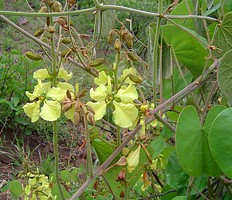Cercideae
Bauhinia subrotundifolia, Illustration
Cercideae is a tribe from the legume family ( Fabaceae or Leguminosae). The up to 300 species are pantropical.
Description
There are evergreen or deciduous shrubs, trees and lianas. There may be tendrils. They are distinguished within the family above all by their Blattspreitenform. The alternate and spirally arranged or distichous leaves are not pinnate. During the growth of the leaves linear growth along the midrib is set relatively early, while it is at the edge of the leaf blade is still ongoing. This gives rise to two-column front ausgerandete leaves. The stomata are usually paracytisch.
The hermaphrodite flowers are more or less strongly zygomorphic and fünfzählig with mostly double, only Brenierea (with the petals missing) simple perianth. There may be a flower cup ( hypanthium ). The five sepals are are fused before anthesis top open or closed and form a ganzranigen, serrated or two-to five-lobed calyx. There are usually ten, rarely less, usually unequal stamens present. Either all stamens fertile or part is converted to staminodes. The stamens can be grown in part. There is only one carpel available. The seeds contain mostly endosperm, not strength, and often have an aril.
System
The Tribe Cercideae is the basal group in the family tree of the Fabaceae. Previously incorporated in the subfamily Caesalpinioideae of today it is not assigned to any of the three subfamilies. A synonym for Cercideae Bronn is Bauhiniaceae Martynov.
The tribe is divided into two Cercideae subtribe. These include, depending on the author about five or up to twelve genera and about 265-300 species:
- Subtribe Cercidinae with the three genera: Adenolobus (. . Harv. ex Benth & Hook f ) Torre & Hillc. The approximately three species are native to southwestern Africa.
- Judas trees ( Cercis L.): With ten species. There are shrubs and small trees. Your areas lie in the Mediterranean climate zones of the Northern Hemisphere.
- Griffonia Baill. The approximately four species are native to western Africa. There are shrubs or lianas
- Bauhinien ( Bauhinia L.; see lat. about 250 to 300 species ): Including Barklya F.Muell, Cardenasia Rusby, Caspareopsis Britton & Rose, Casparia Kunth, Gigasiphon Drake, Lysiphyllum ( Benth. ) de Wit, Pauletia Cav. . Phanera Lour. , Piliostigma Hochst., Schnella Raddi, Tylosema ( Schweinf. ) Torre & Hillc .. Bauhinia s.str. is a genus pantropical 150 to 160 species, there are trees and shrubs. The other genera, if you closely summarizes containing lianas.
- Brenierea Humbert: It is a monotypic genus with the only kind: Brenierea insignis Humbert: This tree or shrub grows at altitudes between 0 and 500 meters to sub-arid sites in Madagascar.
Pedigree:
Swell
- The tribes in the APWebsite. (Section Systematikund description)
- Carole Sinou, Félix Forest, Gwilym P. Lewis, Anne Bruneaua: The genus Bauhinia sl (Leguminosae ): a phylogeny based on the plastid trnL - trnF region. In: Botany. Volume 87, No. 10, 2009 ISSN 1916-2790, pp. 947-960, doi: 10.1139/B09-065.
- Richard P. Wunderlin: Reorganization of the Cercideae ( Fabaceae: Caesalpinioideae ). In: Phytoneuron. No. 48, 2010, ISSN 2153 - 733x, pp. 1-5, online ( PDF, 83 KB).

_in_Hyderabad,_AP_W_IMG_1463.jpg)

_in_Hyderabad,_AP_W_IMG_2574.jpg/440px-Bauhinia_purpurea_(Kaniar)_in_Hyderabad,_AP_W_IMG_2574.jpg)






